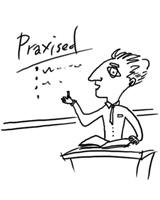When studying vocabulary, many language learners set about memorizing lists of the foreign language words alongside the first corresponding language translations. This is not necessarily a bad approach to quickly memorizing words (if considerations for proper reviews are taken), but it is just a first step towards mastering a new word. There is much more to learning a vocabulary word than simply being able to match a new word with the translation in your native tongue.
‘Depth of vocabulary’ refers to how much a learner knows about a word. Here’s an example. Take the word spend. Initially, a student may just look up the word in a bilingual dictionary to see a single word translation. In Spanish, for example, the translation is pasar. In Korean, spend can be translated into jichulhada (지출하다).
Once the language student memorizes the word pair (pasar = spend/jichulhada = spend), she can now use the word as needed without a problem, right?
Well, not quite. It can be one thing to pass a simple translation vocabulary quiz, and quite another to recognize and produce the word in actual language use. Each word has a different amount of knowledge that learners must attend to, something Paul Nation(2001) refers to as the ‘learning burden’ of a word. Some words pose a very light learning burden. Imageable and concrete nouns such as apple, dog, scissors, etc. tend to have a light learning burden. For example, just knowing that apple in Spanish is manzana is usually enough to plop the word relatively error free into a sentence the next time you want to say ‘apple’ in Mexico.
¿Cómo te gustan los manzanas?
For many other words, verbs and more abstract nouns in particular, there is a lot more the student needs know in order to use them correctly. Going back to the word spend, you need to know that the past tense and past participle is spent, and not spended. It’s helpful to know that the word can be used as a noun in the gerund form (spending). You also need to realize that spend means different things in different contexts. In English we can spend money as well as spend time. In Spanish and Korean, however, different verbs are used for those expressions (gastar dinero vs. pasar tiempo, and doneul jichulhada vs. siganeul bonaeda) and you’ll sound a bit silly mixing them up when speaking in those languages. It would probably be the equivalent of saying ‘I passed $30 on gas this month’ in English).
Fill her up!
There are also restrictions about how to use the word spend. We can spend cash, but we don’t spend credit or spend coupons. A person who regularly spends a lot of money can be referred to as a big spender, but we don’t call a person who avoids spending money a little spender.
Here are some of issues related to depth of vocabulary knowledge(see Nation, 2001 for a complete list), many of which are usually not addressed with rote memorization of vocabulary lists.
- Word recognition
Can the learner readily recognize the word when seen in print and when heard?
As learners of English well know, the way an English word is spelled often fails to correspond to how it is pronounced. There may be a large number of words that students know when they see it in print, but do not recognize when they hear them and vice versa.
- Production
Can the learner say the word with comprehensible pronunciation and spell the word correctly?
- Grammar forms
Does the learner know the different grammatical forms (noun, verb, adjective, etc.) of the word?
- Collocations
What other words commonly occur with the new word, and what combinations of words are not accepted?
Collocations are words that are commonly used together. For example, medicine is used with the word take (Did you take your medicine?). In the Korean language, the direct translation of ‘take medicine’ is ‘eat medicine.’
There are countless others. We go to a hairdresser or barber to get our hair cut, not chopped or severed. We ride a motorcycle, but don’t drive a motorcycle. We go bowling, but do not play bowling. Learning the words ‘cut’, ‘motorcycle’ and ‘bowling’ also involves knowing what words usually go with them and what words do not.
- Colligations
These are like collocations, but refer to grammatical issues. For example, we are interested in skydiving, not interested at skydiving. We avoid watching movies starring Rob Schneider, not avoid to watch.
Ugh.
A word can be paired with a wrong collocation and still be grammatically correct (yet sound awkward), but a word paired with the wrong colligation is considered a grammar error.
- Usage constraints
Is the word more appropriate for formal occasions rather than informal? Is it common in spoken English, but sounds out of place in academic writing? Is it a word only used (and known) to a specific group of people? Is the word out-dated or otherwise used only in specific social contexts?
How to develop depth of vocabulary?
To master a word, there is no way around the fact that you simply have to encounter it hundreds if not thousands of times in a variety of contexts until you develop a strong sense of how the word is and is not used by native speakers. Often the amount of information to know about the word is simply too vast for explicit memorization. This is why most vocabulary scholars acknowledge a strong role for extensive reading and listening.
However, there are some things we can add to explicit study which will give the learner a good start with vocabulary depth. Raising awareness about the most common collocations and relevant colligations is generally helpful. The information given earlier about the word spend, for example, could be enough.
When we first started talking about making what is now the Praxis vocabulary program, there were already a large number of flash-card programs in existence using the spacing effect. What we were interested in doing was going one step further and designing a program in which not only did students increase the amount of vocabulary they knew (quantity), but also develop some depth of vocabulary knowledge(quality). I’m not opposed to simple L1-L2 flashcards. This is an effective way to begin learning vocabulary. It is just a beginning, however, and we believe more can be done.
For each word in the system, Praxis Ed provides 10-14 different exercises and in any given learning session the learner will typically encounter 2-3 of these exercises. The idea is that every time the learner is due to review the words, not only is she getting the needed repetition to keep the word in memory, but she is also learning more about the word as well. In the first learning session, she’ll see the definition, a model sentence, a list of common collocations and colligations, and opportunities to recognize the word in reading and in listening. The following day she’ll be challenged to produce the word and work on spelling. A week later, she’ll encounter it in a new context-rich listening exercise. Later, exercises which develop specific collocations or colligations are added, as well exercises showing the word in new contexts.
Has this worked?
Yes it has. Thanks for asking.
The two published studies on Praxis have both investigated receptive as well as productive skills, and the results are encouraging. Our first study(Miles & Kwon, 2008) measured how well students could recall the word from memory, use it in the correct grammatical form, and spell it correctly. While students using Praxis Ed increased and maintained their knowledge of how to use the words, students working off of bilingual lists lost most of their gains on recalling the words, and made nearly no progress at all on measures of vocabulary depth. This was supported by independent researchers in Japan (Hirschel & Fritz, 2013) who found students using Praxis Ed retained their ability to produce and use the word with more accuracy in comparison to students using vocabulary notebook study methods.
We don’t make any strong claims that a student will ‘master’ a word that is studied on Praxis. There are limitations to what any one product, book, or class can do for a student in the marathon that is learning a second language.However, we do feel students on Praxis Ed get far more bang for their buck by having the opportunity to learn a bit more about the word with each review.
Quality or Quantity?
With the Praxis program, we have the flexibility to allow teachers to decide which way they wish to go in regards to quantity and quality. If they feel it is better for their students to quickly broaden the quantity of their students’ vocabulary, then we have a program for 10 words a day. It still provides a range of activities which gives a fair amount of depth, so quality learning is still happening, but to account for the additional words (while keeping study sessions around 20 minutes) we had to make some reductions in the number of exercises seen per word. I think this option is good for students who need to expand their receptive vocabulary quickly in order to read and listen to a wider range of materials. It can also be a good choice for students preparing for a largely receptive test like the original version of the TOEIC (listening and reading only).
For teachers who lean towards quality over quantity, the number of words per day drops to five. Students get the full variety of exercises to help them develop better usage of the vocabulary. This option is useful for students who need to use the words, as well as understand them when encountered in speech or text.
The default is seven words per day, striking a better balance between quantity and quality. It is the system that has given us the overall best results. We believe that our program along with extensive reading and listening is a powerful combination for vocabulary learning.
Hirschel, R. and Fritz, E. (2013). Learning vocabulary: CALL program versus vocabulary notebook. System, 41(3), 639-653.
Miles, S., & Kwon, C. J. (2008). Benefits of using CALL vocabulary programs to provide systematic word recycling. English Teaching, 63(1). 199-216.
Nation, I.S.P. (2001). Learning Vocabulary in Another Language, Cambridge: Cambridge University Press. (see page 27 for an extensive list of word depth aspects)



